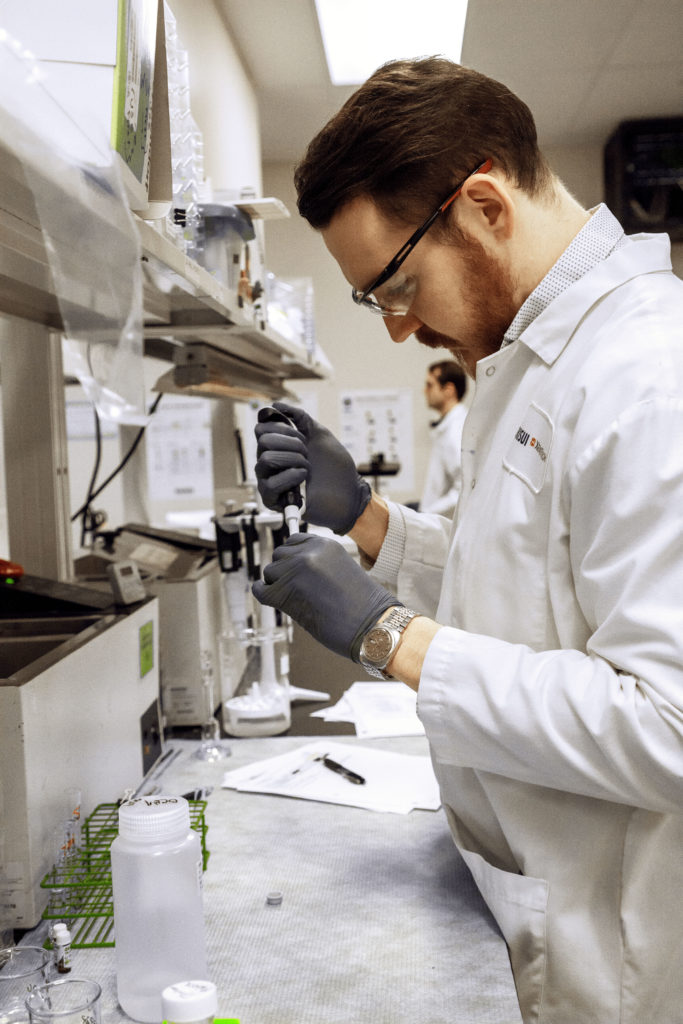
CYP Reaction Phenotyping Studies
Our in vitro Reaction Phenotyping assays use human test systems and recombinant enzyme options to identify which drug-metabolizing enzymes are responsible for metabolism of a compound and can support in vivo data to identify active metabolites.
You can now request quotes for our research services on BioIVT.com!
Whether you need a single assay or a complete ADME program, BioIVT’s experts will help design and implement the appropriate studies for your drug and research objectives. View BioIVT’s comprehensive portfolio of ADME research services.
Compounds with a single route of elimination have a high victim potential. Therefore, regulatory agencies recommend studies to identify enzymes involved in the metabolism of a drug when a clearance pathway constitutes larger than 25% of the total clearance of a drug.
To address the Food and Drug Administration’s direction to “Determine if the investigational drug or metabolite is a substrate of metabolizing enzymes” (In Vitro Drug Interactions Studies— Cytochrome P450 Enzyme- and Transporter-Mediated Drug Interactions: Final Guidance for Industry, FDA 2020) we offer in vitro reaction phenotyping studies designed to meet regulatory expectations (for other guidance-recommended in vitro DDI and metabolism studies, read our overview of regulatory expectations of standard in vitro DDI data for IND).
Our Capabilities
- CYP enzymes
- Use of qualified or validated analytical method to ensure reproducibility of analytical results
- Use of positive control substrates to ensure metabolic competency of test systems
Non-CYP Enzymes
In addition to cytochrome P450 (CYP) enzymes, we can perform a limited-scope (may not include Chemical Inhibition experiments) reaction phenotyping study to evaluate other drug-metabolizing enzymes that may be important to investigate. We can work with:
- UGT enzymes (Use of selective inhibitors for UGT enzymes)
- Flavin-containing monooxygenase (FMO)
- Monoamine oxidases (MAO)
- Aldehyde oxidase (AO)
- Hydrolytic enzymes (carboxylesterases, paraoxonases, cholinesterases)
- Sulfotransferase (SULT)
- GSTA1 and GSTM1
- Carbonyl reductase
Our Approach to CYP and Non-CYP Reaction Phenotyping Studies
Reaction phenotyping studies may be performed based on metabolite formation (quantify the formation of the metabolite) or based on substrate depletion (quantify the substance disappearance). If little is known about a drug’s metabolism, guidance suggests drug developers should identify the responsible enzymes by measuring loss of drug. If all metabolites of a drug are known and metabolite standards are available, then reaction phenotyping can be used to determine which enzyme(s) are responsible for the formation of a particular metabolite.
Regulatory guidance prescribes use of multiple approaches for CYP reaction phenotyping studies, including:
- Metabolism by recombinant human CYP and non-CYP enzymes
- Inhibition approach (antibody and/or chemical inhibition)
In addition to the two required approaches, XenoTech offers a third approach to CYP reaction phenotyping: correlation analysis (details below). Each approach has its advantages and disadvantages, and a combination of approaches is highly recommended.

Standard assays
Standard assays in our CYP reaction phenotyping studies include:
Preliminary Evaluation
Before proceeding with reaction phenotyping of the compound, we conduct an experiment to evaluate the effect of incubation time, protein concentration and substrate concentration on the conversion of the compound to its metabolite(s). This experiment will establish if metabolite formation is proportional to incubation time and protein concentration and help determine if the metabolites are primary metabolites or secondary metabolites. This experiment is performed as a “Preliminary Evaluation” as part of a CYP reaction phenotyping study to establish appropriate incubation conditions for the study.
Recombinant Human CYP Enzymes
Recombinant human CYP enzymes are incubated individually with a test compound to assess the ability of a particular CYP enzyme to metabolize it. Additional experiments may be carried out to allow determination of kinetic constants Km and Vmax for each CYP enzyme that contributes to the reaction.
Chemical Inhibition
Chemical inhibition experiments involve an evaluation of the effect of selective CYP inhibition on the metabolism of a drug in pooled human liver microsomes. Chemical inhibitors can be non-selective when used at inappropriate concentrations. Our team has accumulated extensive experience designing these experiments and avoiding such problems.
Supporting assays for reaction phenotyping studies
We can conduct the following additional assays in support of a contracted reaction phenotyping study:
Determining Michaelis-Menten Kinetic Constants
After the establishment of initial rate conditions (i.e., conditions under which metabolite formation is proportional to incubation time and protein concentration, and the metabolism of the substrate does not exceed 10%), an experiment is typically performed to determine the kinetic constants, namely Km and Vmax. These kinetic constants provide useful information to assess the importance of specific metabolic pathways of the compound. Km and Vmax are determined by incubating microsomes with a range of substrate concentrations, typically 0.1 to 10 times the crude Km value estimated in the experiment to determine initial rate conditions.
Correlation Analysis
Correlation analysis involves determining the rate of drug metabolism by several samples of individual human liver microsomes, followed by correlating reaction rates with sample-to-sample variation of CYP enzyme activity in each individual sample. The FDA September 2006 Guidance for Industry recommends using at least 10 individual donors for this, with sufficient variance between activities to ensure adequate statistical power. This approach is successful because the variation in CYP enzyme activity from sample to sample varies greatly (up to 100-fold) and independently from one enzyme to another. Differences in the rates of formation of the test article metabolites will be compared with the sample-to-sample variation in the following activities:
| Enzyme | Substrate |
|---|---|
| CYP1A2 | Phenacetin O-dealkylation |
| CYP2A6 | Coumarin 7-hydroxylation |
| CYP2B6 | Bupropion hydroxylation |
| CYP2C8 | Amodiaquine N-dealkylation |
| CYP2C9 | Diclofenac 4´-hydroxylation |
| CYP2C19 | S-Mephenytoin 4´-hydroxylation |
| CYP2D6 | Dextromethorphan O-demethylation |
| CYP2E1 | Chlorzoxazone 6-hydroxylation |
| CYP2J2 | Ebastine hydroxylation |
| CYP3A4/5 | Testosterone 6β-hydroxylation |
| CYP3A4/5 | Midazolam 1´-hydroxylation |
| CYP4A11 | Lauric acid 12-hydroxylation |

